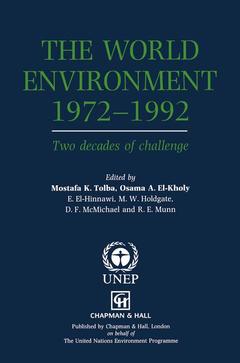Description
The World Environment 1972-1992, Softcover reprint of the original 1st ed. 1992
Two decades of challenge
Author: El-Kholy O.
Language: English
Keywords
air; atmosphere; climate; climate change; environment; health; land degradation; ocean; transport
Approximative price 52.74 €
In Print (Delivery period: 15 days).
Add to cart
Publication date: 10-2013
884 p. · 15.5x23.5 cm · Paperback
884 p. · 15.5x23.5 cm · Paperback
Description
/li>Contents
/li>
Our planet is under siege. Assaults on the atmosphere -the greenhouse effect, the depletion of the ozone layer and increasing air pollution - pose a still unquantified threat to human life. The dumping of hazardous wastes, and land based sources of pollution, present a similar threat to the oceans. On land we are destroying a tropical forest the size of Austria every year, and more than a hundred species of wild plants and animals are lost forever each day. When the General Assembly of the United Nations established UNEP it charged us with reporting on the changing state of the world's environment, tracking the underlying causes of change, and working with governments to develop responses to those changes. Every year since 1974, UNEP has produced a State of the Environment report, focusing on one or more emerging environmental issues and always stressing the human factor -the impact of environmental quality on people and society. Three times since its inception (1982, 198 7 and 1992) UNEP has undertaken a more wide-ranging study. The results of the present study are the most disturbing of the three. However, not all the signs are negative. Throughout the 19 70s and into the 1980s, UNEP was able to report progress in some important areas. Environmental monitoring capacity was being rapidly improved in many parts of the world, and Ministries of the Environment were being set up in an attempt to deal with environmental threats in a more coherent way.
One: The Issues.- 1 Air pollution.- 2 Ozone depletion.- 3 Climate change.- 4 Availability of fresh water.- 5 Coastal and marine degradation.- 6 Land degradation.- 7 Deforestation and habitat loss.- 8 Loss of biological diversity.- 9 Environmental hazards.- 10 Toxic chemicals and hazardous wastes.- Two: Causes and Consequences.- 11 Agriculture and fisheries.- 12 Industry.- 13 Energy.- 14 Transport.- 15 Tourism.- 16 Population and resources.- 17 Human settlements.- 18 Health.- 19 Peace and security.- Three: The Response.- 20 Understanding the environment.- 21 Perceptions and attitudes.- 22 National responses.- 23 International responses.- Four: Looking Ahead.- 24 Challenges and opportunities.- Appendix A Contributors to the report.- Appendix B Reviewers, participants and commentators in workshops.
© 2024 LAVOISIER S.A.S.




